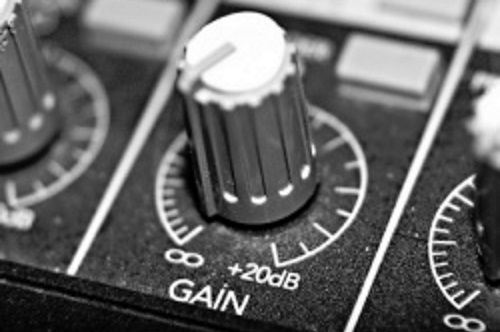A typical mixing console may have dozens, even hundreds of knobs and buttons and faders.
Each one has a specific function, but one is more important than all the rest. It’s typically at the top of the channel strips and it’s called “gain” (or sometimes “trim”), and it’s perhaps the most misused and misunderstood control on the whole board.
Get it set wrong and no amount of fading, EQ or outboard processing will fix it. Get it right and the rest of your mix will come together much, much easier.
So, how do you get it right? Well, it depends. (Great – thanks Mike!) Seriously, it depends—on your board. I wish I could tell you to turn the gain up until you get to 0, then you’re done. That may work, but it may not be optimal.
You have to do some experimenting and listening. Follow along and I’ll walk you through the process, then we’ll look at some specific things to listen for.

For starters, adjusting gain needs to be done in a methodical manner. If you’ve ever been to a concert early and watched a sound check, you’ve seen how it’s done. Turn down all of the faders on the board, and start with the gains all the way counter-clockwise. Start with one instrument, say the kick drum.
Ask the drummer to kick, kick, kick, kick. He keeps going until you tell him to move on. If your board has a PFL or Solo button on the channel, push it for the kick drum (or whatever you’re starting with). The PFL should route that channel to your main meters (check your manual), so keep your eye on it and gradually bring the gain up.
When it starts to peak around 0, you are close. Now you can start bringing up the monitors, and then house fader.
Repeat this process with all the other instruments on stage. Then move on to vocals. (We’ll deal with some more suggestions for a sound check in another post.) You should now have all the instruments and vocals hitting 0 or a little more. At this point, you may be done. Or not.
It all depends on your board. Some boards have a lot more headroom than others, and if you cap the levels at 0, you are not fully utilizing all the gain they have available, and are not maximizing your signal to noise ratio (the difference in signal level between the noise floor and the signal or music).
Other boards are pretty much spent at 0, and if you send 10-16 channels all at 0 to the main bus, it will overload and you will distortion. Or you may just be on the verge of clipping all the time.
This is where you need to listen and pay attention to your board. The console we have at our church will take +8 inputs all day long, mixed into groups and to the mains with no hints of saturation or distortion. So we can run stuff hot, and maximize our signal to noise ratio.
On the other hand, I once used a console at another church that would be completely out of headroom if you ran all the inputs at 0.
Play with your board, try different levels and once you settle on a level that works, stick to it. Make it systematic so everyone uses the same gain structure.
Once it’s repeatable, you’ll have better, more consistent sound every week.




















